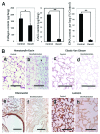Future prospects for tissue engineered lung transplantation: decellularization and recellularization-based whole lung regeneration
- PMID: 24488093
- PMCID: PMC4154954
- DOI: 10.4161/org.27846
Future prospects for tissue engineered lung transplantation: decellularization and recellularization-based whole lung regeneration
Abstract
The shortage of donor lungs for transplantation causes a significant number of patient deaths. The availability of laboratory engineered, functional organs would be a major advance in meeting the demand for organs for transplantation. The accumulation of information on biological scaffolds and an increased understanding of stem/progenitor cell behavior has led to the idea of generating transplantable organs by decellularizing an organ and recellularizing using appropriate cells. Recellularized solid organs can perform organ-specific functions for short periods of time, which indicates the potential for the clinical use of engineered solid organs in the future. The present review provides an overview of progress and recent knowledge about decellularization and recellularization-based approaches for generating tissue engineered lungs. Methods to improve decellularization, maturation of recellularized lung, candidate species for transplantation and future prospects of lung bioengineering are also discussed.
Keywords: decellularization; extracellular matrix; induced pluripotent stem cells; lung transplantation; recellularization; stem/progenitor cells.
Figures



Similar articles
-
Human-scale lung regeneration based on decellularized matrix scaffolds as a biologic platform.Surg Today. 2020 Jul;50(7):633-643. doi: 10.1007/s00595-020-02000-y. Epub 2020 May 4. Surg Today. 2020. PMID: 32363425 Free PMC article. Review.
-
Lung bioengineering: advances and challenges in lung decellularization and recellularization.Curr Opin Organ Transplant. 2018 Dec;23(6):673-678. doi: 10.1097/MOT.0000000000000584. Curr Opin Organ Transplant. 2018. PMID: 30300330 Free PMC article. Review.
-
A nonhuman primate model of lung regeneration: detergent-mediated decellularization and initial in vitro recellularization with mesenchymal stem cells.Tissue Eng Part A. 2012 Dec;18(23-24):2437-52. doi: 10.1089/ten.TEA.2011.0594. Epub 2012 Aug 23. Tissue Eng Part A. 2012. PMID: 22764775 Free PMC article.
-
Decellularized human-sized pulmonary scaffolds for lung tissue engineering: a comprehensive review.Regen Med. 2021 Aug;16(8):757-774. doi: 10.2217/rme-2020-0152. Epub 2021 Aug 25. Regen Med. 2021. PMID: 34431331 Review.
-
Decellularization and Recellularization Methods for Avian Lungs: An Alternative Approach for Use in Pulmonary Therapeutics.Methods Mol Biol. 2022;2394:617-649. doi: 10.1007/978-1-0716-1811-0_33. Methods Mol Biol. 2022. PMID: 35094350
Cited by
-
The billion cell construct: will three-dimensional printing get us there?PLoS Biol. 2014 Jun 17;12(6):e1001882. doi: 10.1371/journal.pbio.1001882. eCollection 2014 Jun. PLoS Biol. 2014. PMID: 24937565 Free PMC article.
-
Revascularization of decellularized lung scaffolds: principles and progress.Am J Physiol Lung Cell Mol Physiol. 2015 Dec 1;309(11):L1273-85. doi: 10.1152/ajplung.00237.2015. Epub 2015 Sep 25. Am J Physiol Lung Cell Mol Physiol. 2015. PMID: 26408553 Free PMC article. Review.
-
Transplantation of bioengineered rat lungs recellularized with endothelial and adipose-derived stromal cells.Sci Rep. 2017 Aug 16;7(1):8447. doi: 10.1038/s41598-017-09115-2. Sci Rep. 2017. PMID: 28814761 Free PMC article.
-
Lung organoids: current strategies for generation and transplantation.Cell Tissue Res. 2022 Dec;390(3):317-333. doi: 10.1007/s00441-022-03686-x. Epub 2022 Sep 30. Cell Tissue Res. 2022. PMID: 36178558 Free PMC article. Review.
-
Lung Microvascular Niche, Repair, and Engineering.Front Bioeng Biotechnol. 2020 Feb 21;8:105. doi: 10.3389/fbioe.2020.00105. eCollection 2020. Front Bioeng Biotechnol. 2020. PMID: 32154234 Free PMC article. Review.
References
-
- Orens JB, Estenne M, Arcasoy S, Conte JV, Corris P, Egan JJ, Egan T, Keshavjee S, Knoop C, Kotloff R, et al. Pulmonary Scientific Council of the International Society for Heart and Lung Transplantation International guidelines for the selection of lung transplant candidates: 2006 update--a consensus report from the Pulmonary Scientific Council of the International Society for Heart and Lung Transplantation. J Heart Lung Transplant. 2006;25:745–55. doi: 10.1016/j.healun.2006.03.011. - DOI - PubMed
-
- Sherry M, Xu J, Kenneth M, Kochanek M. Deaths: Final data for 2010. Natl Vital Stat Rep. 2013;61:1–116. - PubMed
Publication types
MeSH terms
Grants and funding
LinkOut - more resources
Full Text Sources
Other Literature Sources
Medical
